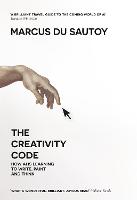|
|
natural language processing
|
|



|
|
| book details |
The Creativity Code: How AI is learning to write, paint and think
By (author) Marcus du Sautoy

|
This book is currently unavailable. Enquire to check if we can source a used copy
|
| book description |
Will a computer ever compose a symphony, write a prize-winning novel, or paint a masterpiece? And if so, would we be able to tell the difference? As humans, we have an extraordinary ability to create works of art that elevate, expand and transform what it means to be alive. Yet in many other areas, new developments in AI are shaking up the status quo, as we find out how many of the tasks humans engage in can be done equally well, if not better, by machines. But can machines be creative? Will they soon be able to learn from the art that moves us, and understand what distinguishes it from the mundane? In The Creativity Code, Marcus du Sautoy examines the nature of creativity, as well as providing an essential guide into how algorithms work, and the mathematical rules underpinning them. He asks how much of our emotional response to art is a product of our brains reacting to pattern and structure, and exactly what it is to be creative in mathematics, art, language and music. Marcus finds out how long it might be before machines come up with something creative, and whether they might jolt us into being more imaginative in turn. The result is a fascinating and very different exploration into both AI and the essence of what it means to be human.
| product details |
Normally shipped |
Publisher | HarperCollins Publishers
Published date | 7 Mar 2019
Language |
Format | Paperback / softback
Pages | 336
Dimensions | 216 x 135 x 21mm (L x W x H)
Weight | 270g
ISBN | 978-0-0083-5425-1
Readership Age |
BISAC | computers / natural language processing
| other options |
|
|
|
To view the items in your trolley please sign in.
| sign in |
|
|
|
| specials |
|

|
Carlo Rovelli
Paperback / softback
208 pages
was: R 295.95
now: R 265.95
|
|
|

|
Carlo Rovelli
Paperback / softback
224 pages
was: R 295.95
now: R 265.95
|
Originally published in Italian: L'ordine del tempo (Milan: Adelphi Edizioni, 2017).
|
|
|
|